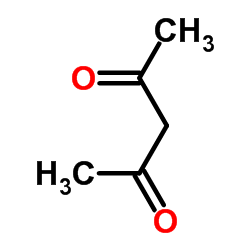2,4-Pentandione

2,4-Pentandione structure
|
Common Name | 2,4-Pentandione | ||
|---|---|---|---|---|
| CAS Number | 123-54-6 | Molecular Weight | 100.116 | |
| Density | 1.0±0.1 g/cm3 | Boiling Point | 138.4±13.0 °C at 760 mmHg | |
| Molecular Formula | C5H8O2 | Melting Point | -23 °C | |
| MSDS | Chinese USA | Flash Point | 43.1±16.8 °C | |
| Symbol |


GHS02, GHS06 |
Signal Word | Danger | |
|
The "New Polyethylene Glycol Dilemma": Polyethylene Glycol Impurities and Their Paradox Role in mAb Crystallization.
J. Pharm. Sci. 104 , 1938-45, (2015) Polyethylene glycols (PEG) represent the most successful and frequently applied class of excipients used for protein crystallization. PEG auto-oxidation and formation of impurities such as peroxides and formaldehydes that foster protein drug degradation is kn... |
|
|
Bi-phasic titanium dioxide nanoparticles doped with nitrogen and neodymium for enhanced photocatalysis.
Nanoscale 7 , 17735-44, (2015) Bi-phasic or multi-phasic composite nanoparticles for use in photocatalysis have been produced by a new synthetic approach. Sol-gel methods are used to deposit multiple layers of active material onto soluble substrates. In this work, a layer of rutile (TiO2) ... |
|
|
Vanadium(IV) and copper(II) complexes of salicylaldimines and aromatic heterocycles: Cytotoxicity, DNA binding and DNA cleavage properties.
J. Inorg. Biochem. 147 , 134-46, (2015) Five copper(II) complexes, [Cu(sal-Gly)(bipy)](1), [Cu(sal-Gly)(phen)] (2), [Cu(sal-l-Ala)(phen)] (3), [Cu(sal-D-Ala)(phen)] (4), [Cu(sal-l-Phe)(phen)] (5) and five oxidovanadium(IV) complexes, [V(IV)O(sal-Gly)(bipy)] (6), [V(IV)O(sal-Gly)(phen)] (7), [V(IV)O... |
|
|
The effect of phosphate on the nuclease activity of vanadium compounds.
J. Inorg. Biochem. 147 , 165-76, (2015) The nuclease activity of VO(acac)2 (1, acac = acetylacetone) and its derivatives VO(hd)2 (2, hd = 3,5-heptanedione), VO(Cl-acac)2 (3, Cl-acac = 3-chloro-2,4-pentanedione), VO(Et-acac)2 (4, Et-acac = 3-ethyl-2,4-pentanedione) and VO(Me-acac)2 (5, Me-acac = 3-m... |
|
|
Liquid chromatographic determination of amikacin sulphate after pre-column derivatization.
J. Chromatogr. Sci. 52(8) , 837-47, (2014) A novel high performance liquid chromatographic (HPLC) method with a pre-column derivatization reaction has been developed and validated. The method was used for the determination of the aminoglycoside antibiotic amikacin sulphate (AMK) in the presence of its... |
|
|
Identifying chelators for metalloprotein inhibitors using a fragment-based approach.
J. Med. Chem. 54 , 591-602, (2011) Fragment-based lead design (FBLD) has been used to identify new metal-binding groups for metalloenzyme inhibitors. When screened at 1 mM, a chelator fragment library (CFL-1.1) of 96 compounds produced hit rates ranging from 29% to 43% for five matrix metallop... |
|
|
Nano gold conjugation, anti-arthritic potential and toxicity studies of snake Naja kaouthia (Lesson, 1831) venom protein toxin NKCT1 in male albino rats and mice.
Indian J. Exp. Biol. 52(8) , 763-72, (2014) Nanoscience and Nanotechnology have found their way in the fields of pharmacology and medicine. The conjugation of drug to nanoparticles combines the properties of both. In this study, gold nanoparticle (GNP) was conjugated with NKCT1, a cytotoxic protein tox... |
|
|
Evaluation of in vitro anti-inflammatory and antibacterial potential of Crescentia cujete leaves and stem bark.
BMC Res. Notes 8 , 412, (2015) The various parts of Cresecentia cujete have some important biological activities. In folklore medicine leaves are used to treat hematomas, tumors and hypertension. Fruit decoction is used to treat diarrhea, stomachaches, cold, bronchitis, cough, asthma, and ... |
|
|
A real-time study of the benefits of co-solvents in polymer solar cell processing.
Nat. Commun. 6 , 6229, (2015) The photoactive layer of organic solar cells consists of a nanoscale blend of electron-donating and electron-accepting organic semiconductors. Controlling the degree of phase separation between these components is crucial to reach efficient solar cells. In so... |
|
|
A facile synthesis of new monoazo disperse dyes derived from 4-hydroxyphenylazopyrazole-5-amines: evaluation of microwave assisted dyeing behavior.
Molecules 17(12) , 13891-909, (2012) A series of new monoazo disperse dyes containing pyrazolopyrimidine moieties was synthesized by coupling malononitrile or 3-aminocrotononitrile with 4-hydroxy- benzenediazonium chloride. Treatment of the resulting products with hydrazine hydrate yields the co... |